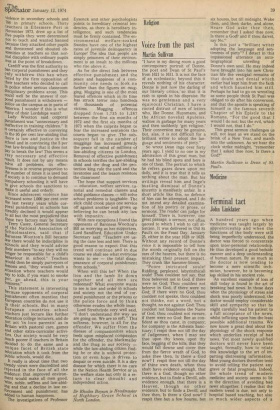Medicine
Terminal tact
John Linklater
A hundred years ago when medicine was taught largely by apprenticeship and when the functions of the body were still • being imperfectly understood, the doctor was forced to concentrate upon inter-personal relationship. He thus developed a good bedside manner and a deep understanding of human nature. By as much as the doctor is now tending to become a mere scientific technician, however, he is becoming lets skilled in his ancient role. -An excellent example of loss of skill today is found in the art of breaking bad news. In those days when the physiology of stress and shock was poorly understood, the doctor would employ considerable skill and sympathy so that he might carefully lead his patient to a full acceptance of the news, whilst inflicting upon him the least possible additional trauma. We now know a great deal about the physiology of the shock response which underlies receipt of bad news. Yet most newly qualified doctors will never have been taught, formally, how to relate this knowledge to the art of imparting distressing information. Most young doctors therefore tend to avoid telling the patient any grave or fatal prognosis. Indeed, the whole trend of modern medicine and society seems to lie in the direction of avoiding bad news altogether. I realise that the modern trend is due, not only to hospital based teaching, but also to much wider aspects of a materialistic society of which the principal aim is material happiness and success and of which the ultimate evil is death.
Bad news causes shock, which is the response to stress when neither fight nor flight are possible. If this shock can be avoided, the recipient stands a better chance of coming to terms with the news, and bad news should therefore be broken as early in the day as possible, or at least when the recipient is not already exhausted. The bearer must be as fully briefed on all details as possible. There is rarely justification for relating a mixture of bad news and unconfirmed rumour which will confuse the clarity of acceptance. The bearer must avoid all the conventional formalising and small talk, and come straight to the point by announcing with deep regret expressed thus, in terms, that he is the bearer of very bad news. There is no place for the taking off of coats, or for the lighting of cigarettes, or for a preliminary drink. By avoiding the conventional exchanges, as well as by his sombre demeanor, the bearer will already be alerting the recipient.
Such an unconscious alert will set the emergency response system into action. Increasing quantities of catechol amins (adrenalin and non-adrenalin) produced by the medulla of the adrenal glands, will begin to circulate in the blood. The effect of these amines takes some two minutes to develop and includes a shift of blood flow from the skin and bowel to the brain and muscle. Peristalsis ceases and the skin becomes pale, while the blood flows more rapidly through the liver where it picks up glucose from the glycogen residue and therefore in turn raises the insulin level. This means that the brain will be receiving additional nourishment and oxygen, and that more glucose will be entering muscle in preparation for possible action. Another catechol amine effect is to increase heart rate and blood vessel tone, thus putting up the blood pressure slightly, and to dilate the coronary arteries thus facilitating the action of the heart. The result of this is virtually to avoid the possibility of a total, complete, cardiovascular collapse.
The recipient is now in a physiologically prepared position to accept a more specific description of the bad news. The aim should be to withold the ultimate detail until such time as the recipient has already guessed it, or actually asks for it. The bearer should therefore narrow down the possibilities, stage by stage.
Every effort should be made to allow the recipient himself to guess as much as possible, and to ask as much as he will. To the correct final question, the answer must be immediate and unambiguous. The recipient, by demon strating the courage to ask, also demonstrates that he is now ready for the reply. Before such final confirmation, however, the recipient must be securely and, if possible, comfortably seated. If he is still standing, or striding restlessly about when he hears the
final words, he is at risk from a sudden lowering of blood pressure in vaso-vagal collapse. It is also of great value for the recipient to have a relative or close friend, other than his doctor, present throughout. The last part of the interview is as important as the first. The bearer should at once begin to ask questions as to the future intentions of the recipient in the light of the bad news just heard. The answers may not be particularly useful or, indeed, coherent, but they will at least certainly force open fresh channels of thought and thus do much to offset the stunning, numbing effect of the news as well as helping to safeguard against total rejection by suicide. In any event the recipient should not be left alone in the house during at least the first twenty-four hours and it is often also useful to allocate a number of simple tasks in order to get the thought processes into coherent action again.
Whatever technique is adopted; bad news remains bad news but, it it is broken with care and humanity, the recipient is at least given a fair .chance of fully accepting and thus of adjusting t° the new and unwelcome situation.



































 Previous page
Previous page